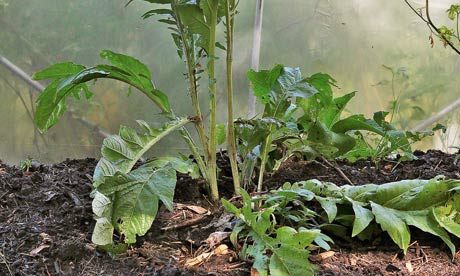I like this a lot and it is another form of something I've always been keen on
Alys Fowler: the joys of hugelkultur (or rotting wood to you and me)
A remarkably successful alternative take on the raised bed, using an old wooden trunk and very little effort

'A damned happy
habitat': In simple terms, hugelkultur is little more than a raised bed
with very steep sides.
Photograph: Simon Wheeler
When I moved on to my plot, I inherited a leylandii trunk that
was far too big to cut up by hand. It was at best something to perch on,
which is exactly what I did with it until I read Sepp Holzer's Permaculture
(Permanent Publications, £18.95). Here I found my solution: a raised
bed that looks after itself. Powered by rotting wood, it needs no
feeding or watering for years. It's called hugelkultur, and it works
remarkably well.
Hugelkultur, in simple terms, is a raised bed with very steep sides. Deep at the centre of the bed is rotting wood, brush or other bulky organic material, covered with upturned turf and topsoil. The wood at the centre acts like a sponge, absorbing water and releasing heat as it breaks down. It also feeds the bed, slowly releasing nutrients. It's best if the wood is a whole trunk, because this rots slowly and steadily, rather than all at once (which is what happens if you use bark chippings).
The wood has to be buried deep, though, or you get a huge amount of nitrogen lock-up. As wood breaks down, it robs nitrogen from the soil to aid decomposition; once broken down, it releases it again, but that is some time away and nearby plants may struggle, especially if they're trying to establish themselves.
My trunk was 10ft long, a foot or so across and just beginning to rot, so perfect for the job. It was buried to where the soil changed colour and became heavier, and on top went brambles, twigs, more brush and very rough compost and autumn leaves. I also put in some nettle and comfrey tops, to help with potential nitrogen lock-up issues. I had no turf to hand, so a layer of grass clippings and then topsoil went on top.
I have not watered or fed anything, and yet I harvest well. It is also rich in wildlife, acting as a giant beetle hotel. And when you dig around, you can see find strands of mycorrhizal fungi going to work on the wood. In short, it is a damned happy habitat. As the motto goes, "Feed your soil and it feeds you."
full article is inline at: http://www.guardian.co.uk/lifeandstyle/2012/sep/07/hugelkultur-permaculture-gardening-alys-fowler
Hugelkultur, in simple terms, is a raised bed with very steep sides. Deep at the centre of the bed is rotting wood, brush or other bulky organic material, covered with upturned turf and topsoil. The wood at the centre acts like a sponge, absorbing water and releasing heat as it breaks down. It also feeds the bed, slowly releasing nutrients. It's best if the wood is a whole trunk, because this rots slowly and steadily, rather than all at once (which is what happens if you use bark chippings).
The wood has to be buried deep, though, or you get a huge amount of nitrogen lock-up. As wood breaks down, it robs nitrogen from the soil to aid decomposition; once broken down, it releases it again, but that is some time away and nearby plants may struggle, especially if they're trying to establish themselves.
My trunk was 10ft long, a foot or so across and just beginning to rot, so perfect for the job. It was buried to where the soil changed colour and became heavier, and on top went brambles, twigs, more brush and very rough compost and autumn leaves. I also put in some nettle and comfrey tops, to help with potential nitrogen lock-up issues. I had no turf to hand, so a layer of grass clippings and then topsoil went on top.
I have not watered or fed anything, and yet I harvest well. It is also rich in wildlife, acting as a giant beetle hotel. And when you dig around, you can see find strands of mycorrhizal fungi going to work on the wood. In short, it is a damned happy habitat. As the motto goes, "Feed your soil and it feeds you."
full article is inline at: http://www.guardian.co.uk/lifeandstyle/2012/sep/07/hugelkultur-permaculture-gardening-alys-fowler
No comments:
Post a Comment